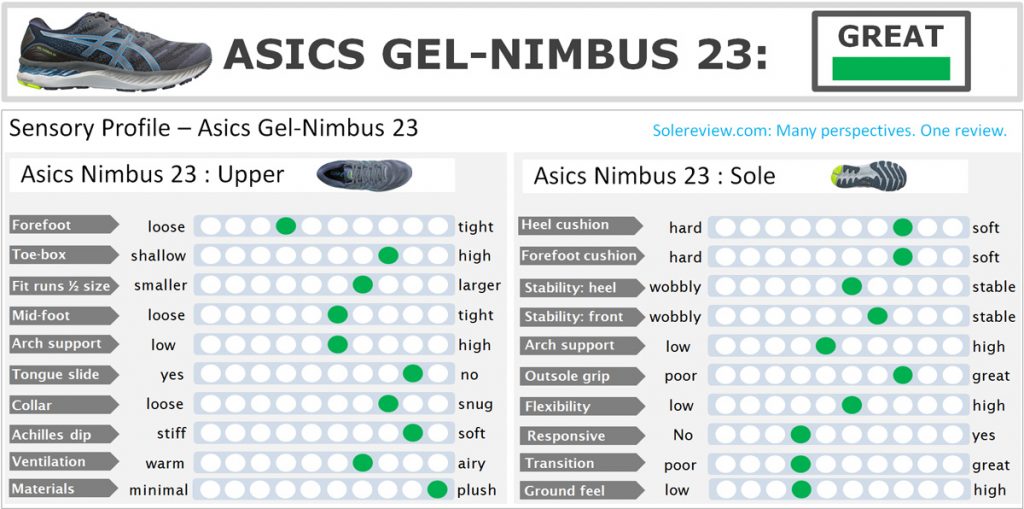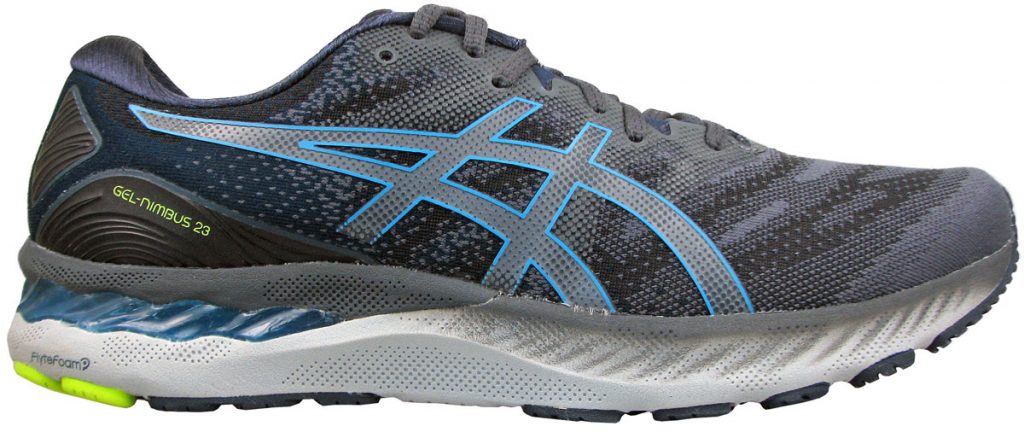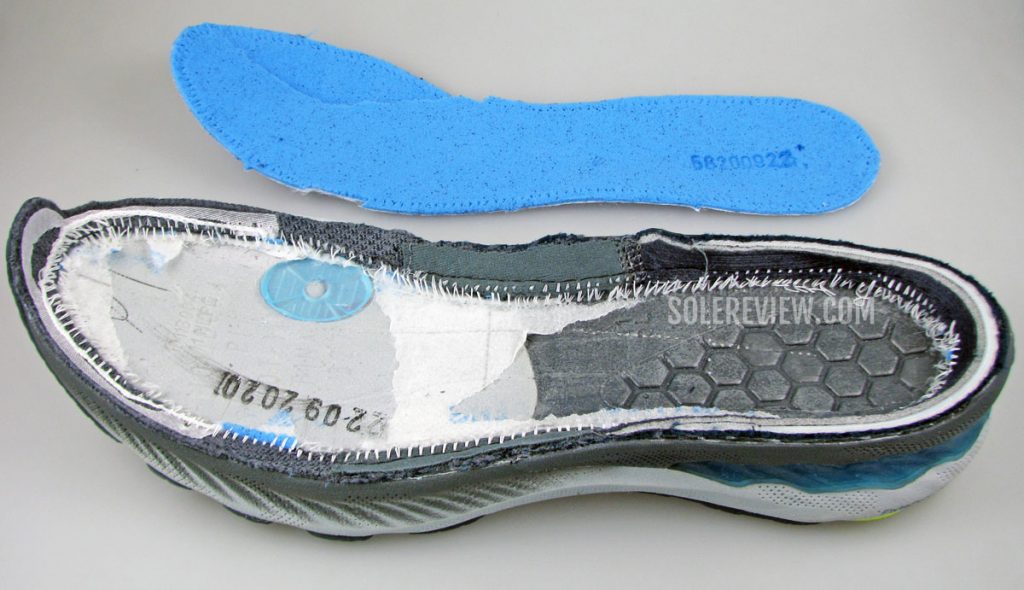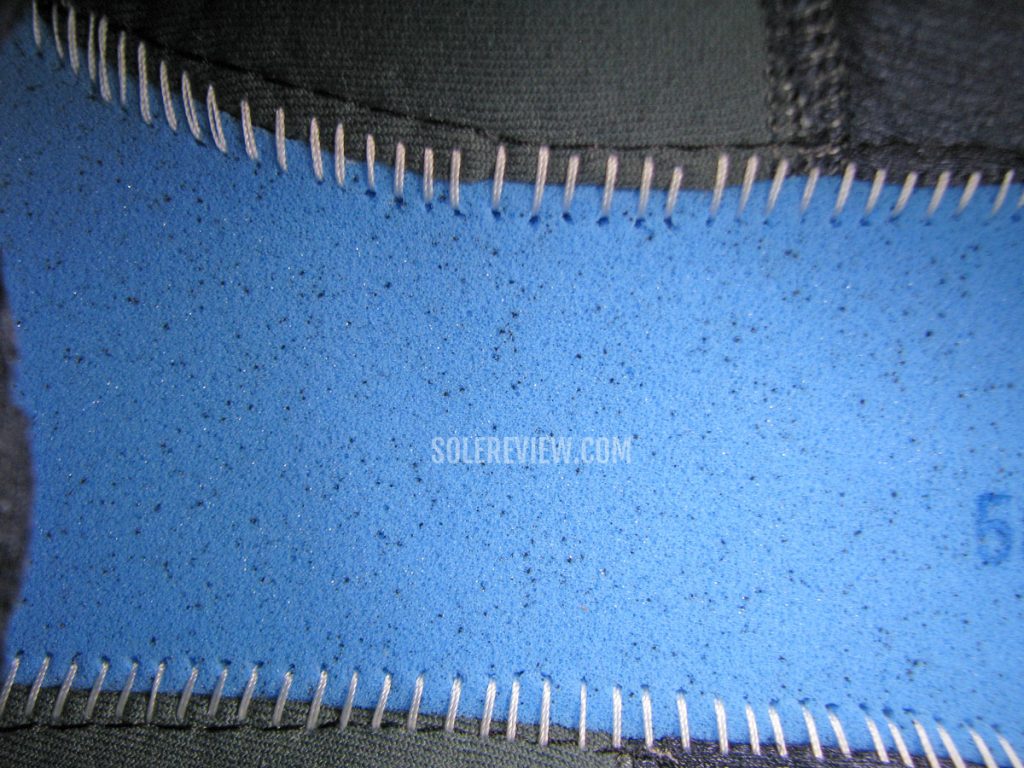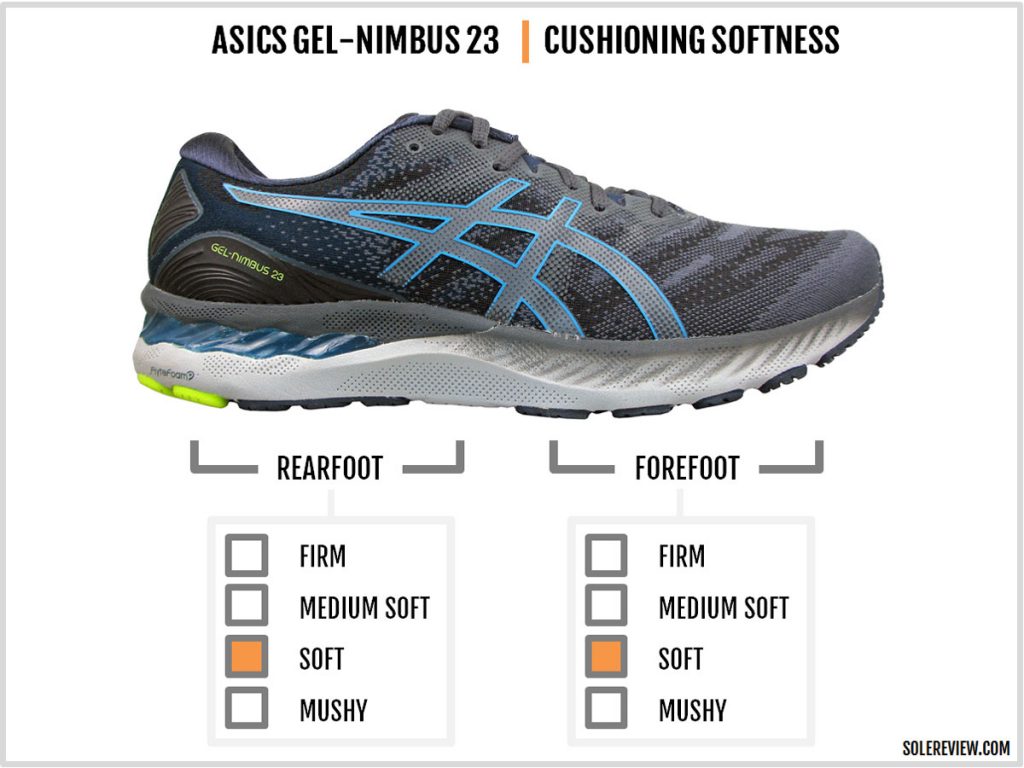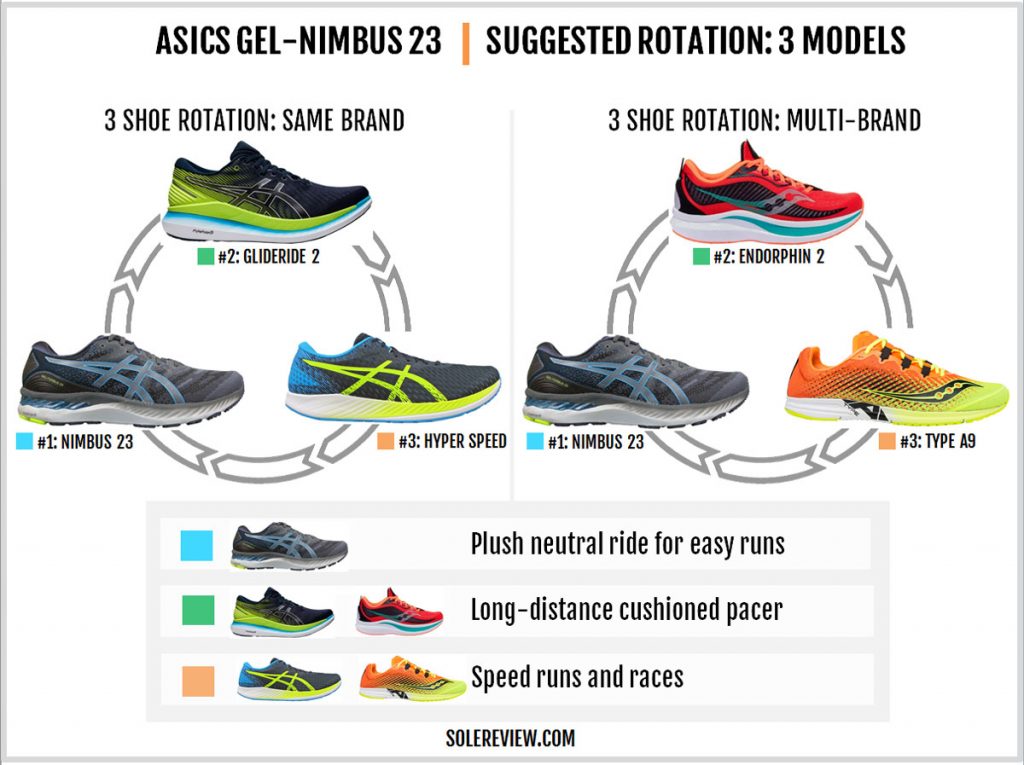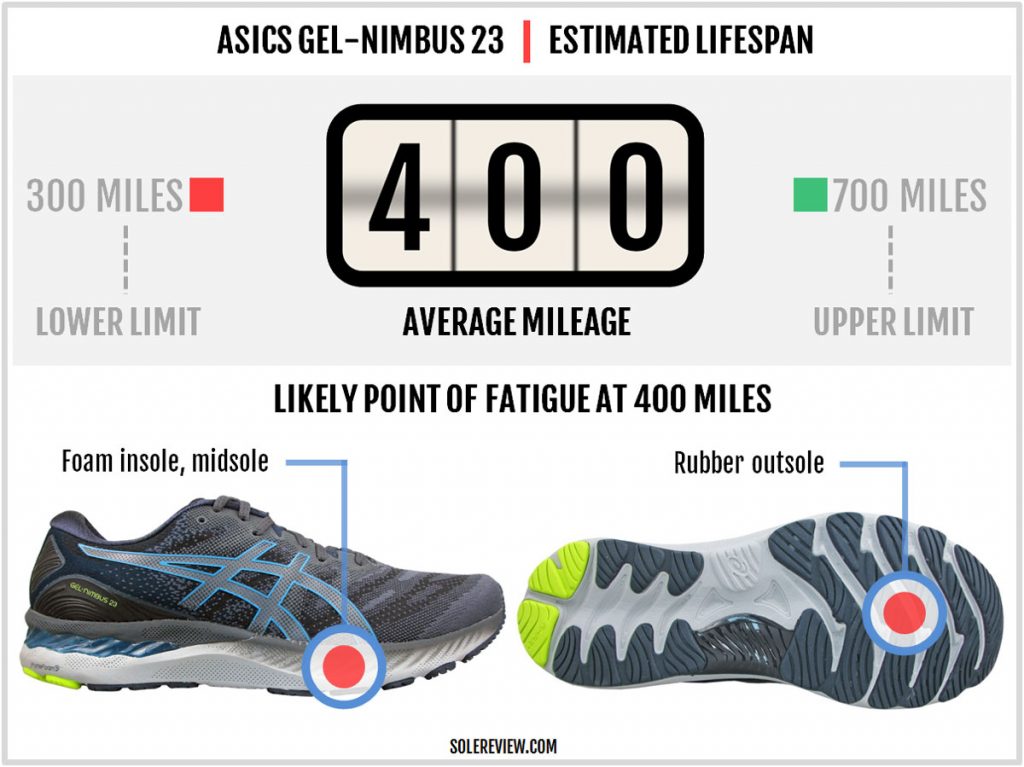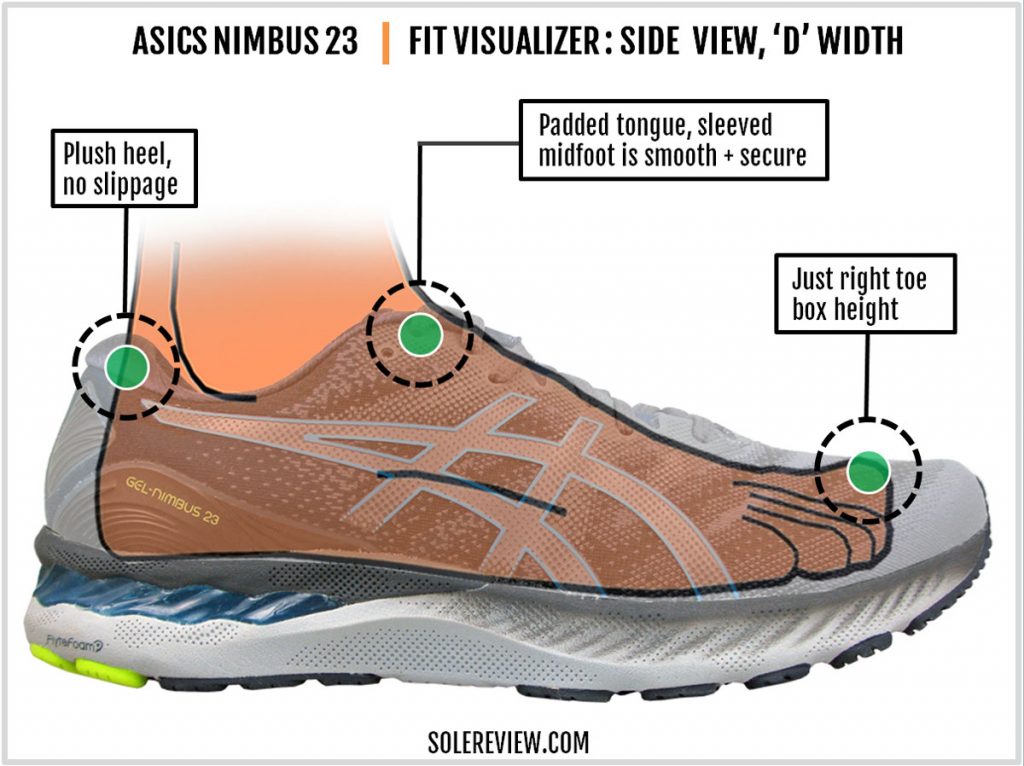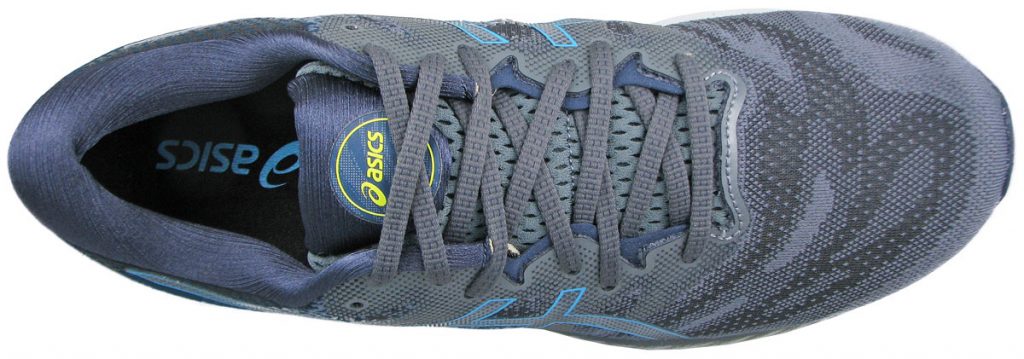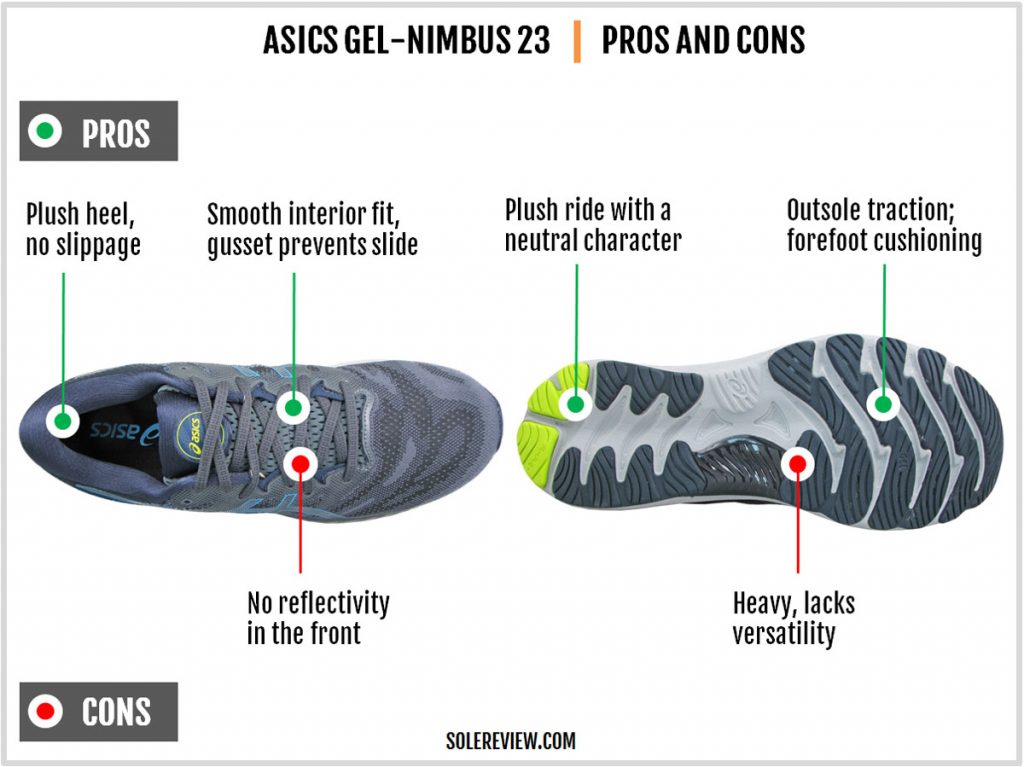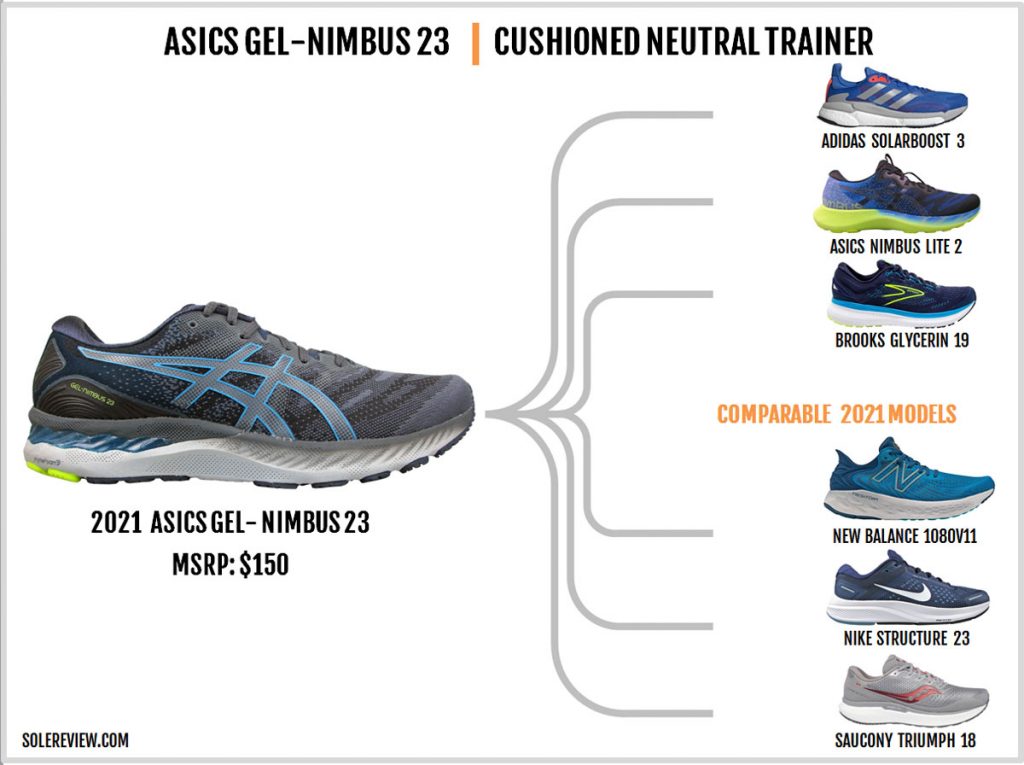The Asics Nimbus 23 was purchased at full retail price for this review.
INTRODUCTION
Related read: The Nimbus 23 teardown – a detailed dissection of the midsole and upper to show you what’s inside.
The scorecard may have you wondering if the Asics Nimbus 23’s ‘great’ rating is warranted.
After all, we have awarded a ‘good’ rating to the Nike Invincible Run and the Asics Nimbus Lite 2. Even the excellent Saucony Endorphin Speed only managed a ‘good’ score.
So is the Nimbus 23 better than all of them?
Not really. Our rating system can be confusing to newer readers, but it follows a consistent methodology. Our ratings are contextual to a specific category.
Here, the Asics Nimbus represents the group of plush neutral trainers with a soft ride. These shoes aren’t meant to be very versatile; they’re perfect for runs at unhurried paces where comfort, not speed, takes precedence.
Admittedly, these feel old-school in the age of PEBA midsoles and Carbon plates, but there’s a familiar – and comforting – charm about them.
So while the Nimbus 23 may not necessarily be a great running shoe to do it all, but it is certainly a great Nimbus. It’s the kind of shoe that we always wanted the Nimbus to be when we first began reviewing this model.
For many years, Asics seemed to have conveniently forgotten that both the Nimbus and Cumulus were named after clouds – a metaphor for a generously plush ride experience these shoes were supposed to deliver.
There were some years when the Nimbus turned out to be a very stiff running shoe. In 2015, the Nimbus 17 went all the way to the mushy end of the cushioning scale.
The Asics Nimbus 23 gets nearly everything right, and we hope that the successive versions maintain this streak.
The completely redesigned midsole produces a near-perfect balance of cushioning and support, and the true-to-size upper is packed with plushness. The Nimbus 23 is classic Asics; unlike the lighter Nimbus Lite 2, the shoe is replete with traditional trims, both cosmetic and functional. The visible Gel pad, plastic shank, and upper detailing are a few examples.
2020 was a very unusual year, and the familiarity of the Nimbus 23’s traditional form factor is oddly comforting and therapeutic – it takes us back to the times when life ebbed and flowed in all its chaotic normalcy.
THE ASICS NIMBUS 23 vs. 22
Though both versions weigh the same, there are plenty of updates under the hood. The 23 is softer and smoother due to several changes; the foam layers are softer, the heel crash pad is now split for softer landings, and the midfoot transitions are smoother because of the lowered plastic shank.
The upper mesh is softer, smoother, and has an inner gusset – a feature that was missing on the Nimbus all these years.
So is the Nimbus 23 worth the switch from the Nimbus 22? If you’ve ground your 22 to the ground, then yes – absolutely.
THE RIDE EXPERIENCE
The Asics Nimbus 23 was a very easy running shoe to review, because the midsole and outsole are based on a tried-and-tested formula.
A base midsole layer of soft single-density foam runs from the heel to the forefoot. A visible Gel pad wraps around the heel, with most of it concentrated on the lateral (outer) side.
A firmer piece of foam sits above the Gel pad and extends to the midfoot.
However, the role of the Gel units in the cushioning delivery is a very minor one. Nearly 100% of the cushioning is delivered by the foam.
The rearfoot Gel is mostly cosmetic, and the forefoot Gel is too diminutive to make a difference.

The ‘Guidance line’ is history. The forefoot has blown rubber strips, and the heel has a harder-wearing compound.
The outsole geometry is similar to the last Nimbus, but with noteworthy updates. The rubber lugs are arranged sideways, and are separated by channels of soft midsole foam.
Unlike the older Nimbus models, the ‘Guidance line’ no longer runs down the center. Only the rearfoot has a soft zone with exposed midsole foam. A plastic half shank adds structure to the inner (arch) side, whereas the outer midfoot is filled with foam.
The Nimbus employs two different kinds of outsole rubber. The forefoot is padded with a softer blown rubber, whereas the heel has the harder compound that Asics calls AHAR, or Asics High Abrasion Rubber for short.
Finally, this 10 mm offset midsole is topped with two cushy layers of the lasting and insole – both being Ortholite variants made of soft, blown foam.
This setup results in a predictable ride behavior. First, the upper layers of the insole and lasting provide a plush step-in experience that’s accessible at all speeds – be it walking or during long-distance cruising.
Since most of the visible Gel is situated laterally, the cushioning has a slight bias towards the outer midsole. However, the overall heel has decent levels of support with a cushioning delivery that feels fairly neutral.
The internal counter (on the upper) locks the heel securely, and the firmer wedge above the Gel unit restricts the potential rolling of the foot. The exposed area of soft under the heel centers the weight as well.
Though the forefoot midsole lacks a wide flare, the stability is decent – and we feel that the secure upper fit also plays a role by preventing the foot from sliding off the midsole edge.
Rearfoot striking activates the outsole crash pad and bottom layer of the Flytefoam midsole. The lower midsole is softer than the top layer of Flytefoam, so it works together with the split outsole to produce a soft yet smooth transition during landings.
The two-piece outsole at the heel landing zone (in Lime green) is separated from the rest of the outsole by a foam channel. From a functional perspective, the split outsole works independently without making its hardness noticeable.
For a shoe this soft, the transition quality isn’t bad at all.
The firmer wedge of foam prevents the foot from sinking into the heel, and also facilitates the transitions from the heel to midfoot.
The midfoot area is supported by the TPU shank (Trusstic in Asics-speak) and foam pillar, so there’s no sense of missing midsole or gap. The forefoot is covered mostly with rubber strips separated by narrow foam channels, and that delivers dependable outsole traction during push-offs.
The forefoot feels slightly lumpy when loaded but we’re not sure why that is.
Since it’s not the outsole, it could be the Gel pocket under the forefoot. If that’s the case, we’ll come to know soon enough; we plan to tear down the Nimbus in July.
Given the concentration of all the cushioning tech in the heel and the 10 mm heel-to-toe offset, rearfoot striking comes naturally to the Nimbus.
That said, forefoot or midfoot landings do not feel like a struggle. The edge of the heel has nearly no overhang – in other words, it doesn’t extend (rearwards) past the heel, so this makes full-contact easier – and more so than the Nimbus 22.
The Nimbus 23’s ride isn’t mushy but there’s softness – and plenty of it. This makes long-distance runs extremely comfortable, so this is an excellent pick for those easy days.
The cushioned chassis also means that this is no speed demon – the Nimbus 23 is at its happiest when it’s used as a leisurely cruiser. At paces of 6 min/km (or 10 min/miles), the nuanced character of the Nimbus comes to the foreground. Unlike the high-tech Asics Glideride, there’s no ‘Guidesole’ plate to make the transitions easier; the foot has to work its way through the softness here.
Responsiveness – or the spring-like quality – is all but absent on the Nimbus. And that’s ok – it’s not supposed to be a bouncy shoe.
If you have some cash to spare, the Asics Metaracer works out to be an excellent racing companion for the Nimbus. Else, the more affordable Asics Hyper Speed (our review here) or Saucony Type A9 will do.
Even though the Nimbus 23 has plenty of cushioning, it’s not a shoe for peppy long-distance runs. Here’s where the Asics GlideRide 2 comes in handy; its plate-equipped midsole makes transitions faster and more fun.
For better performance, consider the Saucony Endorphin Speed V2 as a rotational companion. Its Nylon-plated midsole made of lightweight PEBA foam makes runs peppy with plenty of long-distance comfort. We reviewed the Endorphin Speed V1 recently, and it’s got an identical ride as the V2.
IS THE ASICS NIMBUS 23 DURABLE?
Though the Nimbus 23 uses a standard outsole layout under an EVA foam midsole, the overall build has a familiar robustness that bodes well for durability. The segmented outsole manages the daily wear and tear well, and the Flytefoam midsole is good for at least 400 miles.
The lifespan of the upper has seldom been a problem – the robust exterior will likely outlive the rest of the Nimbus 23.
THE UPPER DESIGN AND FIT
When we say that the Nimbus 23 is a great Nimbus, that applies to the entire shoe and not just the midsole. The upper, too, has all the qualities required that a Nimbus should ideally possess.
For example, the material package looks and feels premium. The tongue and heel lining has a soft hand feel with a generous amount of padding that wraps around the foot in a pillowy, yet secure plushness.
While the mesh doesn’t have any stretch, it is soft, smooth, and without any bumpy hotspots.
Making the fit better this time is a tongue gusset that wraps the midfoot. We’ve never encountered a Nimbus with a tongue-anchoring gusset, so this is a big deal.
The gusset design is deserving of a mention.
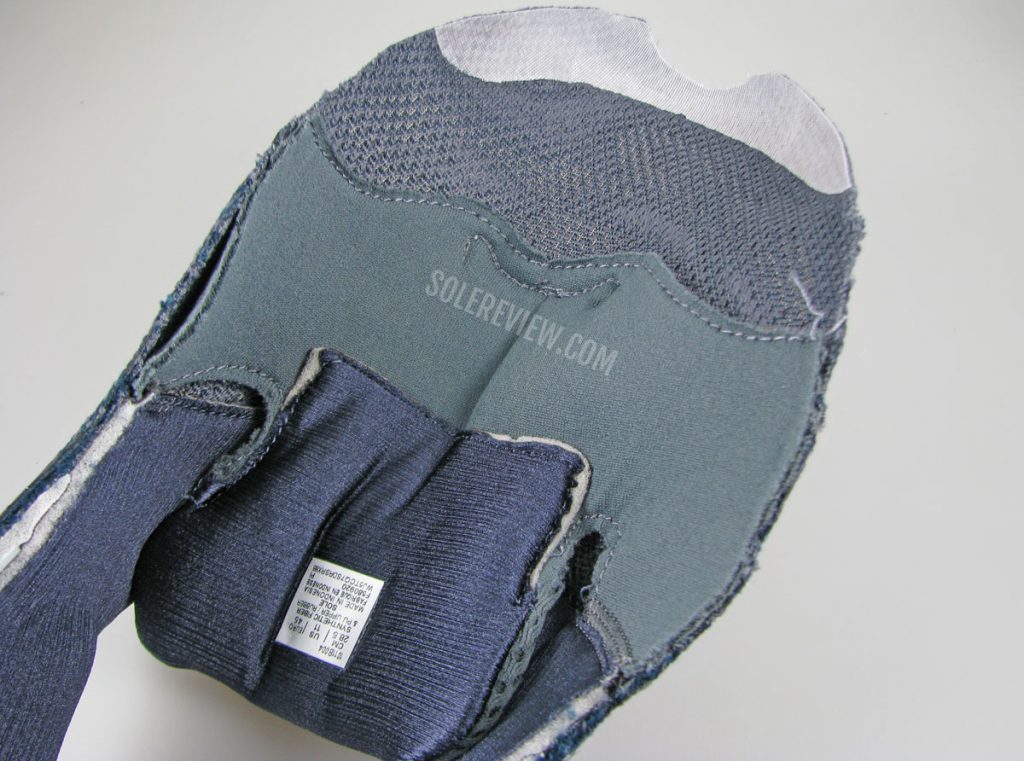
The upper is soft and plush. Note that the inner sleeve spans across the entire midfoot; the tongue flap is attached to it.
Unlike most gussets that happen to be a separate piece of fabric stitched to the tongue flap, the tongue and gusset here are made of a single piece. So there’re no seams to speak of – the upper tongue extends down to the sides and forms the gusset.
The use of a soft spacer mesh here results in a very comfortable fit experience. The laces are slightly elastic and soft to the touch, thus adding to the overall plushness of the upper. The tongue is adequate long should a runner’s loop or heel-lock lacing become necessary.
For regular-shaped feet, the Nimbus 23’s fit is perfect. The fit is secure without being narrow, and there’s an optional wide (2E) as a backup.
The Nimbus 23 fits true to size and has a broad toe-box with sufficient clearance around the toes, both horizontally and vertically. Unlike the full sleeve of the Nike Structure 23 or Brooks Glycerin 19, the Nimbus 23’s midfoot-only gusset does not affect the forefoot and toe-box space.
When viewed from the outside, the exterior shell has a tightly knit texture. But take a look inside the toe-box; the shoe isn’t as warm as it looks.
It’s a healthy balance between breathability and insulation, thus making it a good all-season shoe.
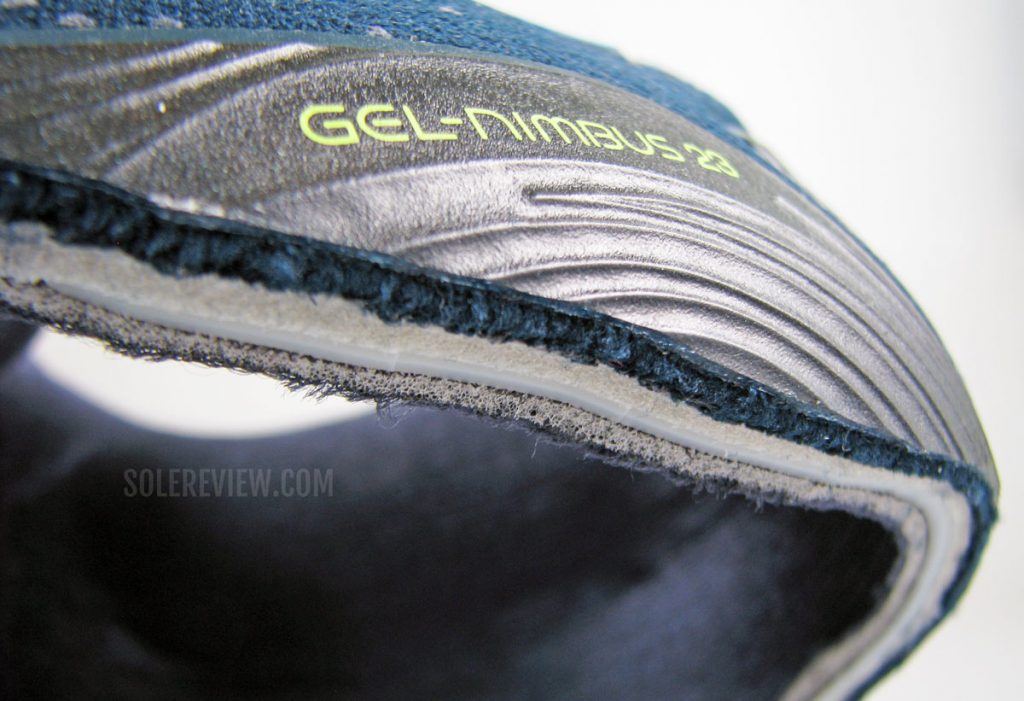
The heel counter (white plastic sheet) is sandwiched between the mesh layers to make the heel supportive and grippy.
The heel grip is excellent; the internal counter works together with the padded collar to produce a no-slip fit quality.
We’re slightly disappointed at the level of reflectivity, though. The heel has a reflective strip, but nowhere as luminous as the Nimbus Lite 2 or Kayano Lite.
PROS AND CONS
Except for the Nimbus 23’s weight (10.9-ounces, 310 grams), there’re no real flaws to speak of. Ok, maybe the reflectivity could be better – considering how well some of the other Nimbus models fare in this regard. The Nimbus Lite 2 and Kayano Lite are good examples.
The versatility isn’t great, but then, the Nimbus was always supposed to a plush and supportive running shoe – a character that usually demands compromises in other performance aspects like a speed-friendly ride and weight.
There’s a lot to like about this shoe, because it embodies everything that a Nimbus should have. The ride is soft through the midsole, but isn’t unstable. The upper has excellent interior proportions, and balances plushness with fit security. The outsole grips well.
Other shoes do a lot of things better than the Nimbus, but then, we have to remember what the Asics Nimbus is meant for.
THE ASICS NIMBUS 23 vs. CUMULUS 23
It’s no coincidence that both the Cumulus and Nimbus share the ’23’ suffix.
Both have co-existed for more than two decades, and represent a familiar pairing of shoes. The Nimbus is the plusher and premium version of the Cumulus, and that’s achieved by the thicker midsole, larger visible Gel pads, plastic half-shank, and a plusher upper – all of which add up to an extra ounce in weight.
The Nimbus 23 uses a softer Flytefoam Propel over the Cumulus’s standard Flytefoam. The Cumulus makes a case for itself as a relatively lighter shoe that feels faster.
This difference in the ride character makes the Cumulus a more versatile daily trainer for a price that’s $30 less expensive. So you see, it’s not just about the difference in overall plushness.
SHOES SIMILAR TO THE ASICS NIMBUS 23
Asics sells another neutral trainer called the Nimbus Lite 2. During our review, we found that the shoe performs as advertised – it’s a lighter version of the Nimbus that delivers mileage-friendly cushioning without the frills. There’re no visible Gel pads or a plastic shank – just a Flytefoam midsole with small (internal) gel units.
The Brooks Glycerin 19 is also similar in overall character and ride quality. It does feel smoother due to the single-density midsole but has that 10-ounce heft to it. The Mizuno Wave Sky 4 is a heavier shoe that has that plush yet robust build – and there’s no plastic ‘Wave’ plate involved in the cushioning delivery, it’s all foam.
Nike doesn’t have a direct Nimbus competitor, but we see the Structure 23 to be comparable. It’s got a cushioned and supportive ride that happens to be reasonably versatile, while being plusher than the Vomero 15.
The New Balance 1080 V11 has a thick cushioning stack, but feels ‘faster’ than the Nimbus due to its rocker shape and snug upper. It comes in several widths as well.
As non-EVA midsole options, the adidas Solar Boost 3 and Saucony Triumph 18 do well.
The adidas shoe is softer, whereas the Triumph’s e-TPU midsole (Pwrrun+) produces a firmer and more resilient ride that’s better suited for higher intensity workouts than the Nimbus.
Do you own this shoe? Improve this review by sharing your insights – submit a review here.

